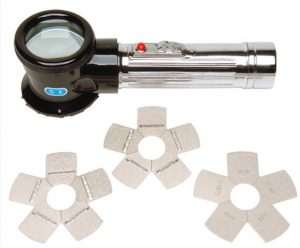Elcometer 127 Keane-Tator Surface Comparators & Magnifier

Product Description
The Elcometer 127 Surface Comparators are available in sand, shot or grit surface profiles.
Each surface comparator is supplied with 5 profile grades ranging from 0.5 – 5.5mils.
Designed for use with the Elcometer 127 illuminated magnifier, each surface comparator has a hole in the centre allowing for clear visual comparisons to be made.
5 Roughness Values per Comparator
The Elcometer 127 Surface Comparators can be used in accordance with:
• AS 3894.5
• ASTM D 4417-A
• SSPC PA 17
*Standards not in bold have been superseded but are still recognised in some industries.
Specifications
Elcometer-127-Keane-Tator-Surface-Comparators-Magnifier – Specifications
| Part Number | Description | Section Profiles |
| E127—-2 | Elcometer 127 Sand Surface Comparator | 0.5, 1, 2, 3, 4 mils |
| E127—-3 | Elcometer 127 Grit Surface Comparator | 1.5, 2, 3, 4.5, 5.5 mils |
| E127—-4 | Elcometer 127 Shot Surface Comparator | 2, 2.5, 3, 4, 5.5 mils |
| E127—-1 | Illuminated magnifier (x 5) with integrated surface comparator holder | – |
Packing List
- Elcometer 127 Keane Tator Surface Comparator and Magnifier
Data Sheet
Elcometer-127-Keane-Tator-Surface-Comparators-Magnifier – Data Sheet
Elcometer-127-Keane-Tator-Surface-Comparators-Magnifier Data Sheet
Standards
The Elcometer 127 Surface Comparators can be used in accordance with:
• AS 3894.5
• ASTM D 4417-A
• SSPC PA 17
*Standards not in bold have been superseded but are still recognised in some industries.
Video
Elcometer 127 Keane-Tator Surface Comparators & Magnifier – Video
Surface Comparators are used to quickly assess the surface profile of a blasted metal surface.
Surface Comparators are a flat, steel plate which contain a number of reference surface profiles, formed on a corrosion resistant metal.
These reference profiles are then compared to the freshly blasted surface – many comparators have a hole in the middle to make this comparison easier – and a profile grade is then defined by the inspector.
Due to the speed of the test, this method is especially useful when you want to go from blasting to painting as quickly as possible to avoid flash rust, or when measuring in hazardous areas where electronic equipment is prohibited.
Elcometer has a range of surface comparators for use with different standards and for different profile finishes.
With all loose dust and debris removed from the test surface, place the appropriate surface comparator against it, and compare, in turn, the test surface with each segment of the comparator.
This can be done with the assistance of a magnifier if necessary. We recommend a x5 magnifier, as it allows you to easily compare the surface with a single segment of the comparator in great detail.
If visual assessment proves difficult, it is possible to do a tactile assessment – in other words, touch.
Once you’ve assessed the profile against each segment of the comparator, you determine the grade. This is not a case of simply choosing which segment the profile is closest to – it is defined as follows:
If the profile is smoother than segment 1, the finest grade on the comparator, it is Finer-than-Fine.
If the profile is equal to segment 1 and up to, but excluding segment 2, it is Fine.
If the profile is equal to segment 2 and up to, but excluding segment 3, it is Medium.
If the profile is equal to segment 3 and up to, but excluding segment 4, it is Coarse.
And finally, if any profile is assessed as being rougher than segment 4, it is Coarser-than-Coarse.
Simply record your result, and then test another area of the surface.

